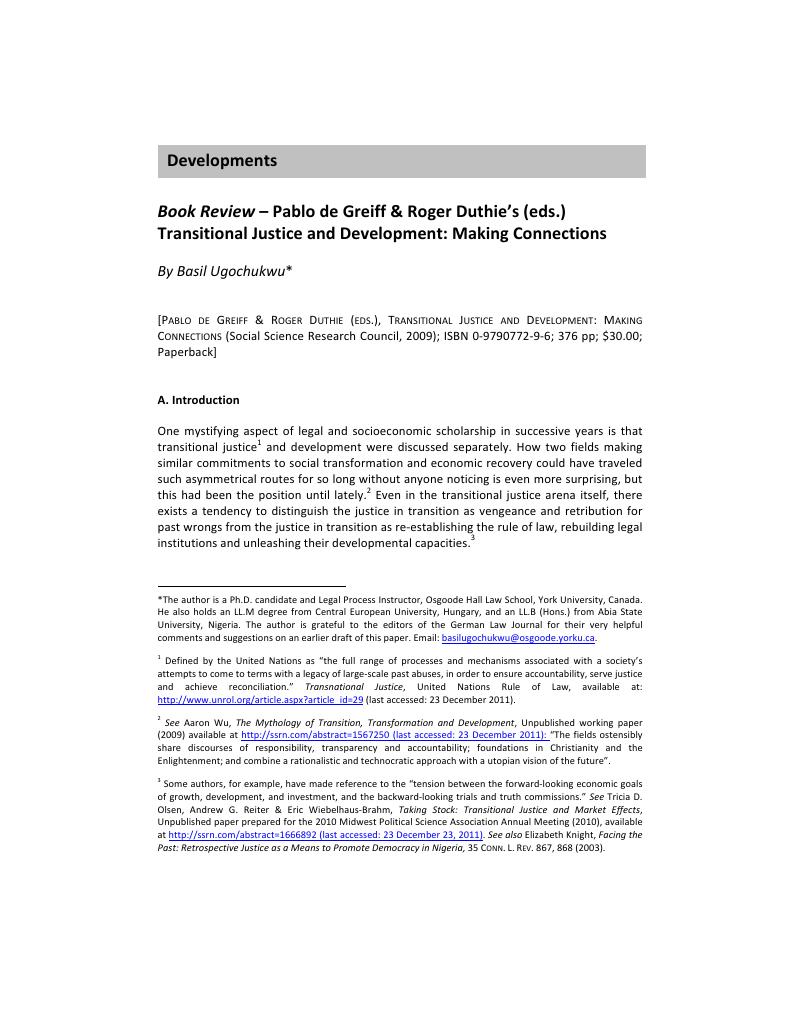Article contents
[Pablo de Greiff & Roger Duthie (eds.), Transitional Justice and Development: Making Connections (Social Science Research Council, 2009); ISBN 0-9790772-9-6; 376 pp; $30.00; Paperback]
Published online by Cambridge University Press: 06 March 2019
Abstract

- Type
- Developments
- Information
- Copyright
- Copyright © 2012 by German Law Journal GbR
References
1 Defined by the United Nations as “the full range of processes and mechanisms associated with a society's attempts to come to terms with a legacy of large-scale past abuses, in order to ensure accountability, serve justice and achieve reconciliation.” Transnational Justice, United Nations Rule of Law, available at: http://www.unrol.org/article.aspx?article id=29 (last accessed: 23 December 2011).Google Scholar
2 See Wu, Aaron, The Mythology of Transition, Transformation and Development, Unpublished working paper (2009) available at http://ssrn.com/abstract=1567250 (last accessed: 23 December_2011): “The fields ostensibly share discourses of responsibility, transparency and accountability; foundations in Christianity and the Enlightenment; and combine a rationalistic and technocratic approach with a utopian vision of the future”.Google Scholar
3 Some authors, for example, have made reference to the tension between the forward-looking economic goals of growth, development, and investment, and the backward-looking trials and truth commissions.” See Tricia D. Olsen, Andrew g. Reiter & Eric Wiebelhaus-Brahm, Taking Stock: Transitional Justice and Market Effects, Unpublished paper prepared for the 2010 Midwest Political Science Association Annual Meeting (2010), available at http://ssrn.com/abstract=1666892 (last accessed: 23_December 23, 2011). See also Knight, Elizabeth, Facing the Past: Retrospective Justice as a Means to Promote Democracy in Nigeria, 35 Conn. L. Rev. 867, 868 (2003).Google Scholar
4 Trubek, David & Galanter, Marc, Scholars in Self-estrangement: Some Reflections on the Crisis in Law and Development Studies in the United States, Wis. L. Rev. 1062 (1974).Google Scholar
5 Id. at 1073.Google Scholar
6 Id. at 1074.Google Scholar
7 Chukwumerije, Okezie, Rhetoric Versus Reality: The Link Between the Rule of Law and Economic Development, 23 Emory Int'l L. Rev. 383, 386 (2009).Google Scholar
8 Transitional Justice and Development: Making Connections 17 (Pablo De Greiff & Roger Duthie eds., 2009).Google Scholar
9 Id. Google Scholar
10 Id. at 18.Google Scholar
11 Id. Google Scholar
12 Id. Google Scholar
13 Id. at 29.Google Scholar
14 Id. Google Scholar
15 Id. at 30.Google Scholar
16 Id. at 77.Google Scholar
17 Id. at 83.Google Scholar
18 Id. at 111.Google Scholar
19 Id. at 114.Google Scholar
20 Id. at 148.Google Scholar
21 Id. at 173.Google Scholar
22 Id. Google Scholar
23 Id. Google Scholar
24 Id. Google Scholar
25 Id. at 148.Google Scholar
26 Id. at 215.Google Scholar
27 Sen, Amartya, What is the Role of Legal and Judicial Reform in the Development Process?, Unpublished paper presented at the World Bank Legal Conference on the Role of Legal and Judicial Reform in Development (2000).Google Scholar
28 Id. Google Scholar
29 Greiff, De, supra note 8, at 283.Google Scholar
30 See, e.g., Olsen, supra note 3. The authors examine the effect of transitional justice mechanisms (trials, truth commissions, and amnesties) on the perceptions of private investors.Google Scholar
31 These factors include domestic prosecutions that are neither systematic nor timely, truth-seeking and reparations measures implemented in the contexts of political compromise and limited resources and a general weakness of state institutions. See Bosire, Lydia, Overpromised, Underdelivered: Transitional Justice in Sub-Saharan Africa, Unpublished Paper, International Centre for Transitional Justice, Occasional Paper Series 1 (2006).Google Scholar
32 Backer, David, Watching a Bargain Unravel? A Panel Study of Victims’ Attitudes about Transitional Justice in Cape Town, South Africa, 4 Int'l J. Transitional Just. 443, 444 (2010).Google Scholar
33 Id. at 444.Google Scholar
34 Id. at 443.Google Scholar
35 Olsen, Tricia, Payne, Leigh, Reiter, Andrew & Wiebelhaus-Brahm, Eric, When Truth Commissions Improve Human Rights, 4 Int'l J. Transitional Just. 457, 458 (2010).Google Scholar
36 Aolain, Fionnuola Ni & Campbell, Colm, The Paradox of Transition in Conflicted Democracies, 27 Hum. Rts. Qtr'ly 172, 173 (2005).Google Scholar
37 See Backer, supra note 32, at 444.Google Scholar
38 This is probably why it is very important to clarify “transition” especially in the context of “developing societies.” Some of the questions may be: “What constitutes a ‘transition'? Is the transition marked simply by the political choice to use of the rhetoric of justice and reconciliation, even in a context of minimum breach in the past, perhaps in order to ‘create the democratic possibility to re-imagine the specific paths and goals of democratization'? Can a country have a succession of transitions and apply transitional justice measures each time? Are these measures appropriate even in contexts of weakly institutionalized states without a history of Western-style democratic tradition”? See Bosire, supra note 31, at 8.Google Scholar
39 Hall, Ruth & Ntsebeza, Lungisile, Introduction, in The Land Question in South Africa: The Challenge of Transformation and Redistribution 2 (Lungisile Ntsebeza & Ruth Hall eds., 2007). See also Kollapen, Jody, Keynote Address to the Opening Session of the Japan International Cooperation Agency and International Centre for Transitional Justice Workshop on Enhancing Socio-Economic Justice in Societies in Transition: Case Studies on the African Continent, Cape Town, South Africa (2008).Google Scholar
40 Greiff, De, supra note 8, at 130.Google Scholar
41 Id. at 130.Google Scholar
42 Posner, Eric & Vermeule, Adrian, Transitional Justice as Ordinary Justice, 117 Harv. L. Rev. 761, 763 (2004).Google Scholar
43 Id. at 766.Google Scholar
44 Greiff, De, supra note 8, at 173.Google Scholar
- 1
- Cited by




